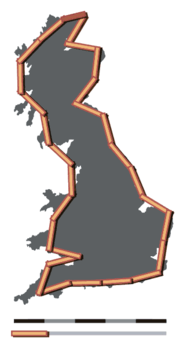Coastline paradox
The coastline paradox is the counterintuitive observation that the coastline of a landmass does not have a well-defined length. This results from the fractal curve-like properties of coastlines, i.e., the fact that a coastline typically has a fractal dimension (which in fact makes the notion of length inapplicable). The first recorded observation of this phenomenon was by Lewis Fry Richardson[1] and it was expanded upon by Benoit Mandelbrot.[2]


The measured length of the coastline depends on the method used to measure it and the degree of cartographic generalization. Since a landmass has features at all scales, from hundreds of kilometers in size to tiny fractions of a millimeter and below, there is no obvious size of the smallest feature that should be taken into consideration when measuring, and hence no single well-defined perimeter to the landmass. Various approximations exist when specific assumptions are made about minimum feature size.
The problem is fundamentally different from the measurement of other, simpler edges. It is possible, for example, to accurately measure the length of a straight, idealized metal bar by using a measurement device to determine that the length is less than a certain amount and greater than another amount—that is, to measure it within a certain degree of uncertainty. The more accurate the measurement device, the closer results will be to the true length of the edge. When measuring a coastline, however, the closer measurement does not result in an increase in accuracy—the measurement only increases in length; unlike with the metal bar, there is no way to obtain a maximum value for the length of the coastline.
In three-dimensional space, the coastline paradox is readily extended to the concept of fractal surfaces whereby the area of a surface varies, depending on the measurement resolution.
Mathematical aspects
The basic concept of length originates from Euclidean distance. In Euclidean geometry, a straight line represents the shortest distance between two points. This line has only one length. On the surface of a sphere, this is replaced by the geodesic length (also called the great circle length), which is measured along the surface curve that exists in the plane containing both endpoints and the center of the sphere. The length of basic curves is more complicated but can also be calculated. Measuring with rulers, one can approximate the length of a curve by adding the sum of the straight lines which connect the points:

Using a few straight lines to approximate the length of a curve will produce an estimate lower than the true length; when increasingly short (and thus more numerous) lines are used, the sum approaches the curve's true length. A precise value for this length can be found using calculus, the branch of mathematics enabling the calculation of infinitesimally small distances. The following animation illustrates how a smooth curve can be meaningfully assigned a precise length:

However, not all curves can be measured in this way. A fractal is, by definition, a curve whose complexity changes with measurement scale. Whereas approximations of a smooth curve tend to a single value as measurement precision increases, the measured value for a fractal does not converge.





As the length of a fractal curve always diverges to infinity, if one were to measure a coastline with infinite or near-infinite resolution, the length of the infinitely short kinks in the coastline would add up to infinity.[3] However, this figure relies on the assumption that space can be subdivided into infinitesimal sections. The truth value of this assumption—which underlies Euclidean geometry and serves as a useful model in everyday measurement—is a matter of philosophical speculation, and may or may not reflect the changing realities of "space" and "distance" on the atomic level (approximately the scale of a nanometer). For instance, the Planck length, many orders of magnitude smaller than an atom, is proposed as the smallest measurable unit possible in the universe.
Coastlines are less definite in their construction than idealized fractals such as the Mandelbrot set because they are formed by various natural events that create patterns in statistically random ways, whereas idealized fractals are formed through repeated iterations of simple, formulaic sequences.[4]
See also
- Alaska boundary dispute – Alaskan and Canadian claims to the Alaskan Panhandle differed greatly, based on competing interpretations of the ambiguous phrase setting the border at "a line parallel to the windings of the coast", applied to the fjord-dense region.
- Coastline problem
- Fractal dimension
- Gabriel's Horn, a geometric figure with infinite surface area but finite volume
- How Long Is the Coast of Britain? Statistical Self-Similarity and Fractional Dimension, a paper by Benoît Mandelbrot
- Paradox of the heap
- Zeno's paradoxes
References
Citations
- Weisstein, Eric W. "Coastline Paradox". MathWorld.
- Mandelbrot, Benoit (1983). The Fractal Geometry of Nature. W.H. Freeman and Co. 25–33. ISBN 978-0-7167-1186-5.
- Post & Eisen, p. 550. (see below)
- Heinz-Otto Peitgen, Hartmut Jürgens, Dietmar Saupe, Chaos and Fractals: New Frontiers of Science; Spring, 2004; p. 424.
Sources
- Post, David G., and Michael Eisen. "How Long is the Coastline of Law? Thoughts on the Fractal Nature of Legal Systems". Journal of Legal Studies XXIX(1), January 2000.
External links
- "Coastlines" at Fractal Geometry (ed. Michael Frame, Benoit Mandelbrot, and Nial Neger; maintained for Math 190a at Yale University)
- The Atlas of Canada – Coastline and Shoreline
- NOAA GeoZone Blog on Digital Coast
- What Is The Coastline Paradox? – YouTube video by Veritasium
- The Coastline Paradox Explained – YouTube video by RealLifeLore


